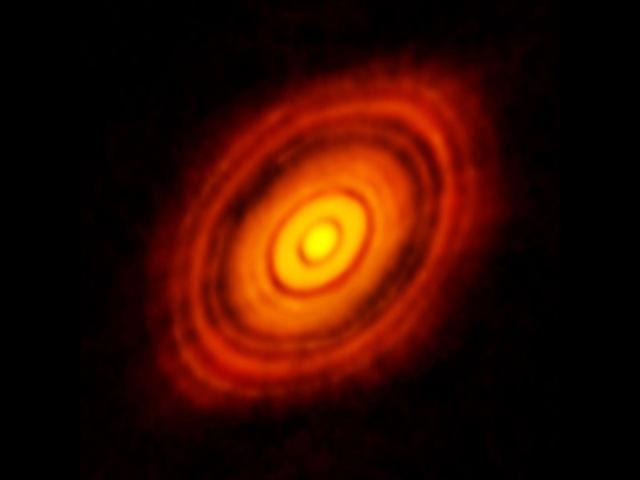May 25 2016
A new analysis of the ALMA data for a young star HL Tauri provides yet more firm evidence of baby planets around the star. Researchers uncovered two gaps in the gas disk around HL Tauri. The locations of these gaps in the gas match the locations of gaps in the dust found in the ALMA high resolution image taken in 2014. This discovery supports the idea that planets form in much shorter timescales than previously thought and prompts a reconsideration of alternative planet formation scenarios.
 This is an ALMA image of the dust disk around HL Tauri. Credit: ALMA (ESO/NAOJ/NRAO)
This is an ALMA image of the dust disk around HL Tauri. Credit: ALMA (ESO/NAOJ/NRAO)
In November 2014, ALMA released a startling image of HL Tauri and its dust disk. This image, the sharpest ever taken for this kind of object, clearly depicts several gaps in the dust disk around the star.
Astronomers have not yet reached a definitive answer for what makes the gaps in the dust disk. Because these disks are the sites of planet formation, some suggest that infant planets are the key; the dark gaps are carved by planets forming in the disk that attract or sweep away the dust along their orbits.
But others doubt the planet explanation because HL Tauri is very young, estimated to be only about a million years, and classical studies indicate that it takes more than tens of millions of years for planets to form from small dust. Those researchers propose other possible mechanisms to form the gaps: changes in the dust size through coalescence or destruction; or the formation of dust due to gas molecules freezing.
More data was needed to determine which theory is correct. We know that the disks around young stars contain gas in addition to the dust. In fact, in general the amount of gas is 100 times larger than that of dust. The research team led by Dr. Hsi-Wei Yen at Academia Sinica Institute of Astronomy and Astrophysics in Taiwan and Professor Shigehisa Takakuwa at Kagoshima University, Japan, focused on the distribution of gas in the disk to better understand the true nature of the disk. If the dust gaps are caused by the variance of the dust properties, that wouldn't directly affect the gas, so no gaps would be seen in the gas distribution. If on the other hand, the gaps in the dust are caused by the gravity of forming planets, the gravity would be expected to created gaps in the gas as well.
Even with ALMA's unprecedented sensitivity, it was not easy to reveal the distribution of gas in the disk. The team extracted the emissions from HCO+ gas molecules in the publicly available 2014 ALMA Long Baseline Campaign data and summed up the emissions in rings around the star to increase the effective sensitivity. This novel data analysis technique yielded the sharpest image ever of the gas distribution around a young star.
The image of HCO+ distribution reveals at least two gaps in the disk, at the radii of 28 and 69 astronomical units. "To our surprise, these gaps in the gas overlap with the dust gaps," said Yen, the lead author of the paper that appeared in the Astrophysical Journal Letters. "This supports the idea that the gaps are the footprints left by baby planets." The fact that the gaps in the dust and the gas match-up implies that the amount of material in the gaps likely decreases. This disfavors some of the theories that tried to explain the gaps solely by changes in the dust particles. A decrease in the amount of material in the gaps supports the planet formation theory, in spite of HL Tauri's young age. "Our results indicate that planets start to form much earlier than what we expected." Yen added.
The team also found that the gas density is high enough to harbor an infant planet around the inner gap. Comparing the structure of the inner gap to theoretical models, the team estimates the planet has a mass 0.8 times that of Jupiter.
On the other hand, the origin of the outer gap is still unclear. The team suggested the possible existence of a planet 2.1 times more massive than Jupiter, but the present research cannot eliminate the possibility that the gap is made by the drag between the dust particles and the gas. To solve this question, more data are needed.
"Our research clearly demonstrates that applying new data analysis techniques to existing data can uncover important facts, further increasing ALMA's already high scientific potential," commented Takakuwa. "Applying the same method to the datasets for other young stars, we expect to construct a systematic model of planet formation."
Source: http://www.nins.jp/english/